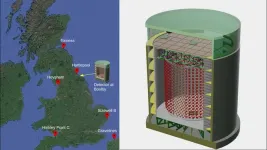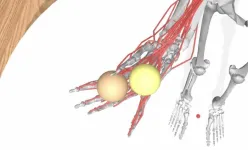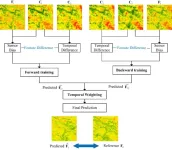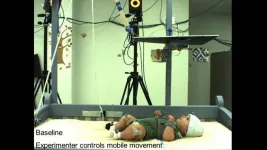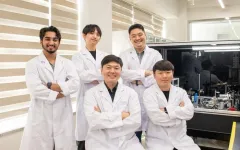(Press-News.org) WASHINGTON, Oct. 1, 2024 – Nuclear fission reactors act as a key power source for many parts of the world and worldwide power capacity is expected to nearly double by 2050. One issue, however, is the difficulty of discerning whether a nuclear reactor is being used to also create material for nuclear weapons. Capturing and analyzing antimatter particles has shown promise for monitoring what specific reactor operations are occurring, even from hundreds of miles away.
In AIP Advances, by AIP Publishing, researchers from the University of Sheffield and the University of Hawaii developed a detector that senses and analyzes antineutrinos emitted by nuclear reactors. The detector designed by Wilson et al. senses antineutrinos and can characterize their energy profiles from miles away as a way of monitoring activity at nuclear reactors.
“In this paper, we test a detector design that could be used to measure the energy of particle emission of nuclear fission reactors at large distances,” said author Stephen Wilson. “This information could tell us not only whether a reactor exists and about its operational cycle, but also how far away the reactor is.”
Neutrinos are chargeless elementary particles that have a mass of nearly zero, and antineutrinos are their antimatter counterpart, most often created during nuclear reactions. Capturing these antiparticles and analyzing their energy levels provides information on anything from operational cycle to specific isotopes in spent fuel.
The group’s detector design exploits Cherenkov radiation, a phenomenon in which radiation is emitted when charged particles moving faster than light pass through a particular medium, akin to sonic booms when crossing the sound barrier. This is also responsible for nuclear reactors’ eerie blue glow and has been used to detect neutrinos in astrophysics laboratories.
The researchers proposed to assemble their device in northeast England and detect antineutrinos from reactors from all over the U.K. as well as in northern France.
One issue, however, is that antineutrinos from the upper atmosphere and space can muddle the signal, especially as very distant reactors yield exceeding small signals — sometimes on the order of a single antineutrino per day.
To account for this, the group proposed to place their detector in a mine more than 1 kilometer underground.
“Discriminating between these particles is also a significant analysis challenge, and being able to measure an energy spectrum can take an impractically long time,” Wilson said. “In many ways, what surprised me most is that this is not actually impossible.”
Wilson hopes the detector stimulates more discussion in how to use antineutrinos to monitor reactors, including measuring the antineutrino spectrum of spent nuclear fuel or developing smaller detectors for use closer to reactors.
###
The article “Remote reactor ranging via antineutrino oscillations” is authored by Stephen Thomas Wilson, James Armitage, Chris Cotsford, Niamh Holland, John G. Learned, and Matthew Malek. It will appear in AIP Advances on Oct. 1, 2024 (DOI: 10.1063/5.0220877). After that date, it can be accessed at https://doi.org/10.1063/5.0220877.
ABOUT THE JOURNAL
AIP Advances is an open access journal publishing in all areas of physical sciences—applied, theoretical, and experimental. The inclusive scope of AIP Advances makes it an essential outlet for scientists across the physical sciences. See https://pubs.aip.org/aip/adv.
###
END
Using antimatter to detect nuclear radiation
Byproducts of fission reactors can provide insight into nuclear reactor use.
2024-10-01
ELSE PRESS RELEASES FROM THIS DATE:
Modeling the minutia of motor manipulation with AI
2024-10-01
In neuroscience and biomedical engineering, accurately modeling the complex movements of the human hand has long been a significant challenge. Current models often struggle to capture the intricate interplay between the brain's motor commands and the physical actions of muscles and tendons. This gap not only hinders scientific progress but also limits the development of effective neuroprosthetics aimed at restoring hand function for those with limb loss or paralysis.
EPFL professor Alexander Mathis and his team have developed an AI-driven approach that ...
Survival gap eliminated for Black cord blood recipients with blood cancers, study finds
2024-10-01
Patients who receive umbilical cord blood transplants for blood cancers now live equally long regardless of their race, new research from UVA Cancer Center shows.
The findings, from UVA Health’s Karen Ballen, MD, and collaborators, suggests that a previously identified survival gap for Black recipients has closed and that overall survival for all recipients has increased.
The retrospective analysis looked at more than 2,600 adults and children with blood cancers who received cord blood between 2007 and 2017 ...
Nominate a stroke hero today: 2025 Stroke Hero Awards open for submissions
2024-10-01
DALLAS, Oct. 1, 2024 – Strokes can strike at any age, challenging survivors to overcome physical, emotional and cognitive changes. Nominations are open now for the 2025 Stroke Hero Awards from the American Stroke Association, a division of the American Heart Association, which is celebrating a century of lifesaving impact this year. The awards recognize stroke survivors, caregivers, advocates and experts making a difference in the stroke community.
Every 40 seconds someone in the U.S. has a stroke[1], according to the American Heart Association’s 2024 Heart Disease and Stroke Statistical Update. Nearly 1 in 4 stroke survivors face the ...
Seven years on, INSEAD study reveals #MeToo's unexpected impact
2024-10-01
Seven years after actor Alyssa Milano’s tweet launched the #MeToo movement into the global consciousness, attitudes towards sexual harassment and assault have shifted in many countries. A new study shows that the movement’s impact doesn’t stop there.
INSEAD professors Frédéric Godart and David Dubois, alongside Clément Bellet of Erasmus University Rotterdam, found that #MeToo triggered far-reaching changes in consumer behaviour. Sales of stereotypically feminine shoes like high heels dropped significantly weeks after the #MeToo movement swept the media ...
Addressing the geriatric healthcare workforce shortage
2024-10-01
INDIANAPOLIS – The pandemic has highlighted the acute shortage of nurses and nursing assistants needed to care for the growing number of older adults in long-term care facilities. Yet getting nursing students excited, engaged and feeling competent to take on the challenges of caring for nursing home patients has proved elusive.
To address this critical workforce gap, researchers from Regenstrief Institute and the Indiana University School of Medicine have developed and tested an innovative curriculum for nursing students, exposing ...
Age trumps gender, income and postcode for consumers' clothing habits
2024-10-01
The first-ever nationwide study into how Australians use and dispose of clothing has revealed people are buying too many clothes and are unsure how to discard them responsibly.
Conducted by RMIT University and commissioned by the Kmart Group and the Queensland Government, a study of 3,080 Australians explored how they acquired, used and disposed of their clothing.
Australians are among the world’s biggest clothing consumers, importing 1.4 billion units or over 383,000 tonnes annually.
But each year, more than 200,000 tonnes of clothing is sent to landfill.
The authors recommend establishing a national textile collection program for unwearable clothing that ...
Researchers develop method to obtain fine spatial and temporal resolution land surface temperature data
2024-10-01
Scientists need fine spatial and temporal resolution land surface temperature (LST) data for many types of research and applications. Spatio-temporal fusion, a technique that combines data from multiple sources to create high-resolution images with both spatial (space) and temporal (time) details, is an important solution for researchers needing fine spatio-temporal resolution LST data. A team of researchers propose a new spatio-temporal fusion method based on Restormer (RES-STF).
Their work is published in the Journal of Remote Sensing on August 21, 2024.
LST data, the measurement ...
Feet first: AI reveals how infants connect with their world
2024-10-01
Recent advances in computing and artificial intelligence, along with insights into infant learning, suggest that machine and deep learning techniques can help us study how infants transition from random exploratory movements to purposeful actions. Most research has focused on babies’ spontaneous movements, distinguishing between fidgety and non-fidgety behaviors.
While early movements may seem chaotic, they reveal meaningful patterns as infants interact with their environment. However, we still lack understanding of how infants intentionally engage with their surroundings and the principles guiding their ...
Addressing health equity in childhood asthma requires engaging affected communities
2024-10-01
NEW YORK, NY (Oct. 1, 2024) – Systemic racism remains a significant challenge in efforts to address health disparities in childhood asthma. A new American Thoracic Society report provides practical frameworks to begin the research necessary to make real progress in treating asthma in Black and Latino children, who are more likely than their white counterparts to report to emergency rooms in the U.S.
Stephanie Lovinsky-Desir, MD, and a diverse group of researchers, clinicians, social scientists and community health workers shared their findings in the report published online this week in ...
Light-based microcapillary monitoring sparks innovation in manufacturing and biotechnology
2024-10-01
Dr. Jaeyeon Pyo of the Smart 3D Printing Research Team at the Korea Electrotechnology Research Institute (KERI) has developed a breakthrough technology that uses light to visualize nanoscale glass microcapillary tips, enabling precise and delicate contact with other objects.
A “‘Microcapillary” is a precision tool with a very small aperture (0.1 mm to 0.000010 mm in diameter) fabricated from a glass tube. It is utilized as a vital tool in various fields, from biotechnology to manipulate cells, to micro electroplating and nano 3D printing. Specifically, it is used in biotechnology faor tasks such as injecting sperm into an egg during in vitro fertilization (IVF) ...
LAST 30 PRESS RELEASES:
Chronic kidney disease poisons patients’ hearts, scientists discover
Hollings researchers reveal why some pancreatic tumors behave differently
DNA ties gut motility to vitamin B1
Study suggests pathway for life-sustaining conditions in Europa’s ocean
Researchers discover potential new target to treat Parkinson’s disease
Global societies unite to address environmental threats to heart health
Artificial light at night extends pollen season
Women see AI as riskier than men do
Push and pull in models of human migration
Mapping comedic timing, ta-da!
SEOULTECH researchers reveal strong public support for hydrogen fuel cell trucks
Dongguk University develops a new way to produce cheaper, more efficient green hydrogen
Scientists discover a hidden RNA “aging clock” in human sperm
New quantum boundary discovered: Spin size determines how the Kondo effect behaves
Ancient ‘spaghetti’ in dogs’ hearts reveals surprising origins of heartworm
Full value added tax on meat: a first step towards pricing the environmental damages caused by diets
Hidden mpox exposure detected in healthy Nigerian adults, revealing under-recognized transmission
Shingles vaccine linked to slower biological aging in older adults
A self-assembling shortcut to better organic solar cells
A two-week leap in breeding: Antarctic penguins’ striking climate adaptation
Climate risks to insurance and reinsurance of global supply chains
58% of patients affected by 2022 mpox outbreak report lasting physical symptoms
Golden Gate method enables rapid, fully-synthetic engineering of therapeutically relevant bacteriophages
Polar weather on Jupiter and Saturn hints at the planets’ interior details
Socio-environmental movements: key global guardians of biodiversity amid rising violence
Global warming and CO2 emissions 56 million years ago resulted in massive forest fires and soil erosion
Hidden order in quantum chaos: the pseudogap
Exploring why adapting to the environment is more difficult as people age
Society for Laboratory Automation and Screening welcomes new scientific director: Madeline M. Farley, Ph.D.
Austrian cow shows first case of flexible, multi-purpose tool use in cattle
[Press-News.org] Using antimatter to detect nuclear radiationByproducts of fission reactors can provide insight into nuclear reactor use.
